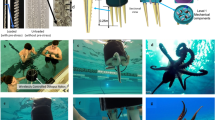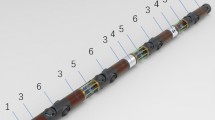Abstract
Underwater robots for inspecting marine structures such as breakwaters, pipes and quay walls require mobility not only for self-transport but for rotation during inspection. To facilitate rotation mobility, we have proposed a portable, lightweight underwater robot whose performance to translate and rotate is achieved by it altering its shape. The shape is that of a three-strut tensegrity structure of three pipes connected with rubber strings. This manuscript describes a transformation mechanism for an underwater robot with a deformable tensegrity structure. The transformation mechanism includes a winding unit with a planetary gear. We show that the transformation mechanism has a self-locking feature by selecting a high gear ratio of the winding unit. We also evaluate the fluid characteristics of the robot with the transformation mechanism in several experiments in a circulating water tank to investigate the effect of the transformation mechanism.












Similar content being viewed by others
Explore related subjects
Discover the latest articles, news and stories from top researchers in related subjects.References
Yoerger D, Slotine J (1985) Robust trajectory control of underwater vehicles. IEEE J Ocean Eng 10(4):462–470
Cui J, Zhao L, Yu J, Lin C, Ma Y (2019) Neural network-based adaptive finite-time consensus tracking control for multiple autonomous underwater vehicles. IEEE Access 7:33064–33074
Takagawa S, Takahashi K, Sano T, Kyo M, Mori Y, Nakanishi T (1989) 6,500m deep manned research submersible Shinkai 6500 system. In: Proceeding of OCEANS, pp 741–746
Matsuda T, Maki T, Sakamaki T (2019) Accurate and efficient seafloor observations with multiple autonomous underwater vehicles: theory and experiments in a hydrothermal vent field. IEEE Robot Autom Lett 4:2333–2339
Tarn TJ, Shoults GA, Yang SP (1996) A dynamic model of an underwater vehicle with a robotic manipulator using Kane’s method. Auton Robots 3:269–283
Leabourne KN, Rock SM (1998) Model development of an underwater manipulator for coordinated arm-vehicle control. In: Proceedings of OCEANS ’98 conference, pp 941–946
Xu F, Wang H, Wang J, Au KWS, Chen W (2019) Underwater dynamic visual servoing for a soft robot arm with online distortion correction. IEEE/ASME Trans Mechatron 24:979–989
Hirose S (1993) Biologically inspired robots: snake-like locomotors and manipulators. Oxford University Press, Oxford
Togawa K, Mori M, Hirose S (2000) Study on Threedimensional Active Cord Mechanism: development of ACMR2. In: Proceedings of the 2000 IEEE/RSJ international conference on intelligent robots and systems, pp 2242–2247
Yamamoto I, Terada Y (2003) Robotic fish and its technology. In: Proceedings of the SICE annual conference
Chunlin Z, Low KH (2012) Design and locomotion control of a biomimetic underwater vehicle with fin propulsion. IEEE/ASME Trans Mechatron 17(1):25–35
Wang H, Wang D, Wang T, Zhang Y, Gu N (2019) Adaptive cooperative diving of saucer-type underwater gliders subject to model uncertainties and input constraints. IEEE Access 7:60042–60054
Eriksen CC, Osse TJ, Light RD, Wen T, Lehman TW, Sabin PL, Ballard JW, Chiodi AM (2001) Seaglider: a long-range autonomous underwater vehicle for oceanographic research. IEEE J Ocean Eng 26(4):424–436
Sherman J, Davis RE, Owens WB, Valdes J (2001) The autonomous underwater glider “Spray”. IEEE J Ocean Eng 26(4):437–446
Doniec M, Vasilescu I, Detweiler C, Rus D (2010) Complete SE3 underwater robot control with arbitrary thruster configurations. In: Proceedings of 2010 IEEE international conference on robotics and automation, pp 5295–5301
Shibata M, Miyamura T, Sakagami N, Miyata S (2013) Use of a deformable tensegrity structure as an underwater robot body. J Robot Mechatron 25(5):804–811
Shibata M, Sakagami N (2014) A portable underwater robot with tensegrity body composed of thruster units. In: Mobile service robotics (CLAWAR2014), pp 503–510
“kennethsnelson.net.”. http://www.kennethsnelson.net/
Paul C, Valero-Cuevas FJ, Lipson H (2006) Design and control of tensegrity robots for locomotion. IEEE Trans Robot 22(5):944–957
Fadeyev D, Zhakatayev A, Kuzdeuov A, Varol HA (2019) Generalized dynamics of stacked tensegrity manipulators. IEEE Access 7:63472–63484
Du W, Ma S, Li B, Wang M, Hirai S (2016) Force analytic method for rolling gaits of tensegrity robots. IEEE/ASME Trans Mechatron 21:2249–2259
Bliss T, Iwasaki T, Smith HB (2013) Central pattern generator control of a tensegrity swimmer. IEEE/ASME Trans Mechatron 18:586–597
Shibata M, Saijyo F, Hirai S (2009) Crawling by body deformation of tensegrity structure robots. In: IEEE international conference on robotics and automation, pp 4375–4380
Acknowledgements
This research was partly supported by a fund for Takahashi Industrial and Economic Research Foundation.
Author information
Authors and Affiliations
Corresponding author
Additional information
Publisher's Note
Springer Nature remains neutral with regard to jurisdictional claims in published maps and institutional affiliations.
This work was presented in part at the 24th International Symposium on Artificial Life and Robotics Beppu, Oita, January 23–25, 2019.
About this article
Cite this article
Shibata, M., Sakagami, N. Deformable tensegrity structure underwater robot with a transformation mechanism. Artif Life Robotics 25, 100–105 (2020). https://doi.org/10.1007/s10015-019-00563-9
Received:
Accepted:
Published:
Issue Date:
DOI: https://doi.org/10.1007/s10015-019-00563-9




